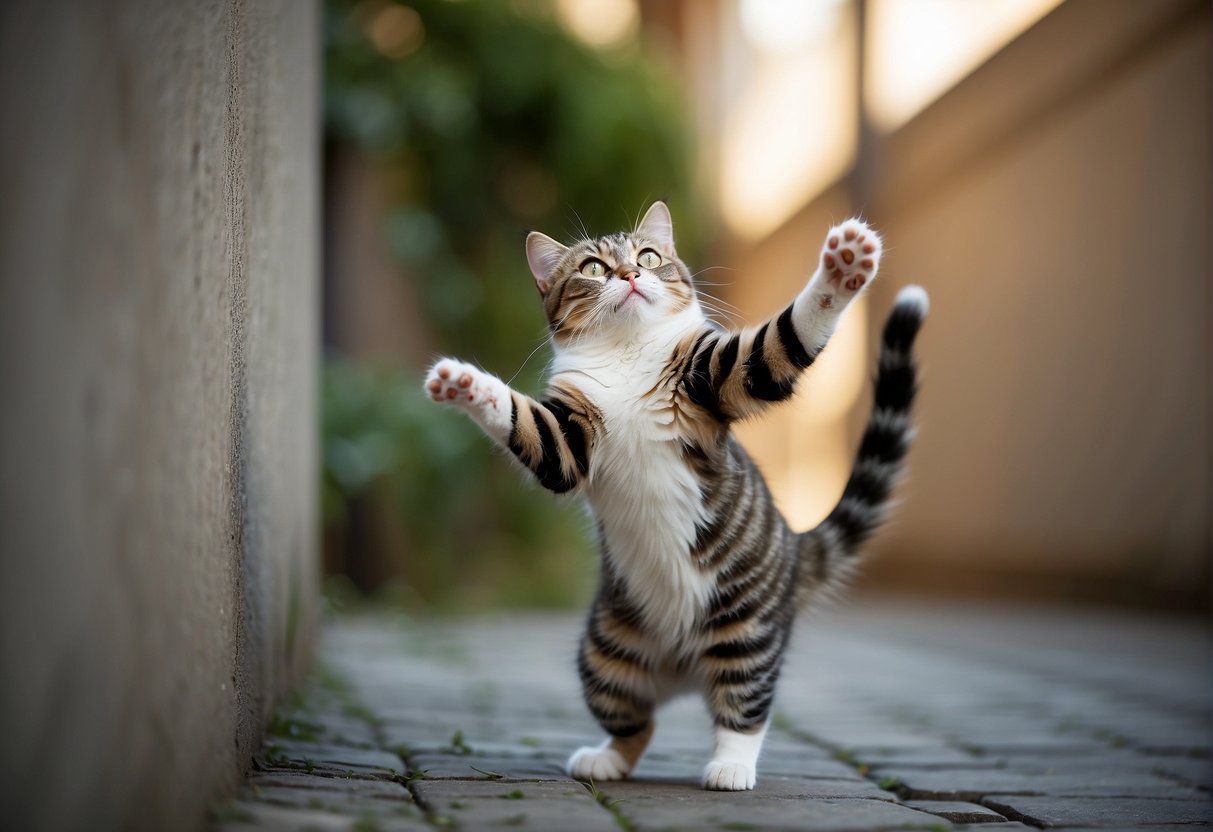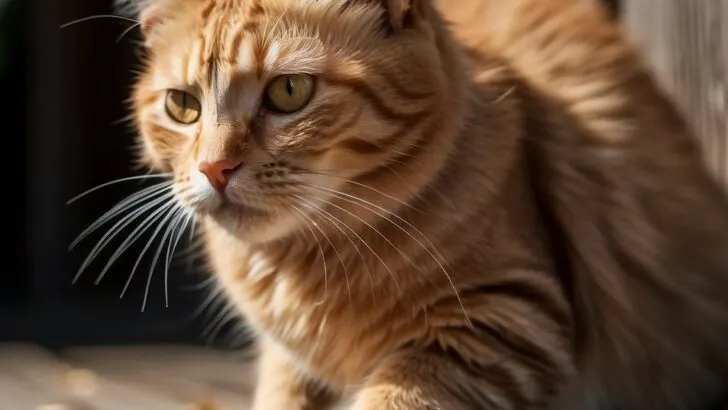Cats scratching walls is a behavior that can puzzle even seasoned cat owners. Imagine you’ve just painted your living room, and there goes your feline friend, claws out, etching lines into your pristine wall.
From personal experience, I know the confusion; you provide scratching posts, yet they still choose the wall. This might seem like willful mischief, but there’s a range of reasons behind this clawing conundrum.

For example, your cat’s scratching might be a form of nail care. Just as we clip our nails, cats need to maintain theirs. They remove the dead outer layers of their claws by scratching, something I’ve noticed when tiny slivers of claw sheath are left behind at the scene.
Scratching also serves as a workout, stretching and flexing their bodies from whiskers to tail – I’ve watched my own cat stretch up and rake their claws down the wall in a satisfying full-body stretch that seems to bring them immense joy.
Beyond physical care, scratching has a communicative purpose in the world of felines. Your walls become a visual and scent-tagged bulletin board announcing their presence. When cats scratch, they release pheromones from their paws, marking their territory in a way that’s clear as day to any other cat that might pass by – although, thankfully, not something we humans can detect.
Wall Scratching Behaviors In Cats

Cats scratch walls for a variety of specific reasons, primarily linked to their natural instincts, territorial markings, and emotional states.
Natural Instincts and Scratching Habits
Cats have a natural instinct to scratch, which serves several purposes. Nail health is paramount; scratching helps cats shed the outer sheath of their nails, maintaining their claws’ sharpness and health. Additionally, scratching is a way for cats to stretch their bodies and flex their feet and claws, helping them to keep their muscles in good condition.
- Nail Care: Cats keep their nails sharp and remove the dead outer sheath by scratching.
- Exercise: Stretching and scratching are methods for cats to maintain muscle health.
Marking Territory and Communication
Your cat’s inclination to scratch walls and objects around the house is also a form of territorial behavior. Scratching leaves both a visual mark and a scent secreted from their paw scent glands, signaling to other animals that the territory is claimed.
This scent marking is a way of communicating with other cats without direct contact.
- Scent Marks: Scratching implants pheromones from scent glands to mark territory.
- Visual Signals: The scratch marks themselves serve as a visual sign of a cat’s presence.
The Role of Stress and Emotion in Scratching
Scratching can be a behavioral indicator of your cat’s internal state. Stress, anxiety, or even excitement can manifest in increased scratching as cats try to relieve their pent-up energy or discomfort.
Providing scratching posts, engaging in play, and creating a comforting environment can help mitigate destructive behaviors and promote feelings of safety and happiness.
- Emotional Outlet: Scratching may increase if a cat feels anxious or stressed.
- Comfort and Energy Release: It provides a way for cats to express emotions and release energy.
Managing and Redirecting Scratching
Cats naturally scratch to keep their claws sharp, stretch their bodies, and mark their territory.
Appropriate Scratching Surfaces
To prevent unwanted scratching, it’s vital to provide appropriate scratching surfaces. Invest in a variety of scratching posts and pads, ensuring they are stable and tall enough for your cat to fully stretch.
Cat trees with integrated scratching surfaces can also entice your cat away from furniture. Place these in areas your cat frequents to make them the most attractive option for a scratch session.
- Tip: If your cat ignores the scratching post, try rubbing it with catnip or hanging a toy on it to make it more appealing.
Training and Positive Reinforcement Strategies
Employ positive reinforcement to teach your cat where to scratch. When your cat uses the scratching post, immediately reward them with treats or affection. This positive association will encourage repeat behavior.
For areas where scratching is not allowed, place double-sided tape or sticky tape; cats dislike the feel and will typically avoid these surfaces.
- Warning: Never scold your cat after the fact—it can cause anxiety and won’t effectively stop the behavior.
Environmental Enrichment for Indoor Cats
Increase your cat’s environmental enrichment to reduce stress and boredom, which often lead to unwanted scratching.
Provide plenty of interactive toys and engage in playtime to tire them out. This not only helps with their exercise needs but also satisfies their natural hunting instincts, which can reduce scratching as a form of entertainment.
- Note: Regularly trim your cat’s nails to minimize damage if they do scratch an unintended area.

My name is James, and welcome to FAQCats!
Along with our team of cat owners, expert pet enthusiasts, and pet professionals, we aim to write engaging helpful, engaging content about cats. At FAQCats we strive to provide content that’s accurate and fun to read. Our team writes about everything related to cats; even the most complex of topics. Through extensive research and caring for our own fur-pals, we’re able to provide something cat owners worldwide will love. Have a look around, and leave us feedback anytime!

